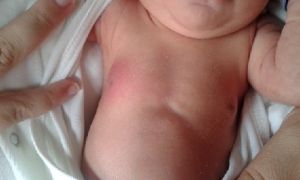Neonatal mastitis
See "Mastitis" for Adolescents or Adults
Background
- Uncommon soft-tissue infection of the breast tissue in children <2mo of age [1]
- More common in females than in males [1]
- More commonly unilateral than bilateral [1]
- Reported confirmed sources have included MSSA and MRSA[1], and rarely acetinobacter [2], e. coli[3], and proteus mirabilis[4]
- Reported sequelae have included brain abscess[5] and osteomyelitis[6]
Clinical Features
- Presentation within 2 months of life with redness overlying the breast tissue and/or possibly purulent discharge from one, or rarely both, nipples.
- Parents may also report other concurrent, but nonspecific concerns such as
- poor feeding
- increased fussiness
- inconsolability
- subjective or measured fevers
- lethargy
Differential Diagnosis
- Cellulitis
- Necrotizing soft tissue infections
- Pediatric fever of uncertain source
- Sepsis (peds)
- Physiologic breast hypertrophy (Neonatal Mastauxe/Giant Mastauxe)
Diagnostic Evaluation of the Febrile and/or Ill-Appearing Infant
- Initiate a complete SBI workup for Pediatric fever of uncertain source[1][7][8][9]
- Neonatal Mastitis should not be relied upon as a diagnosis to exclude other SBI in the febrile or ill-appearing infant
- Consider Sepsis (peds) alerts and bundles per local protocol
Diagnostic Evaluation of the Afebrile, Well-Appearing Infant
- Complete, head-to-toe physical examination
- The infant may have varying degrees of normal breast tissue hypertrophy bilaterally, but lack of breast tissue hypertrophy is not specific against the diagnosis.[10]
- Laboratory workup to include
- Complete blood count
- Basic metabolic panel
- Consider blood cultures
- Consider sending swabs for local site cultures
- Catheterized urine sample and LP are not required [8]
- Imaging
- POCUS assessment for abscess in the ER has not been studied
- Radiology ultrasounds may be ordered at consultant/admitting provider request or per local protocol, may help to identify abscess and guide surgical decision making
Diagnosis
- Neonatal mastitis is a clinical diagnosis which does not require imaging or microbiological confirmation to plan for disposition or begin treatment.[1][9]
- Other diagnoses, such as sepsis, disseminated cellulitis, or necrotizing fasciitis may be made concurrently and should be managed appropriately.
Management
- Initiate IV antibiotics unless strong cause to consider discharge and close outpatient follow-up exists.[1][9]
Disposition
- Patients diagnosed with neonatal mastitis should generally be admitted for antibiosis and close monitoring in the NICU.[1][9]
- Though mortality is very low in the largest multi-center study, severe sequelae have been documented.[9]
- A heavy preference for IV nafcillin as a first-choice antibiotic is shown throughout current literature when MRSA is not strongly suspected.
- If considering discharge with oral antibiotics, strongly consider a consultation with a neonatologist to confirm local practice trends or direct conversation with the patient's pediatrician for confirmation of close follow-up.
See Also
External Links
Pediatric EM Morsels: Mastitis
References
- ↑ 1.00 1.01 1.02 1.03 1.04 1.05 1.06 1.07 1.08 1.09 1.10 Masoodi T, et al. Neonatal mastitis: a clinico-microbiological study. J Neonatal Surg. 2014;3(1):2. Published 2014 Jan 1
- ↑ Mohr EL, Berhane A, Zora JG, Suchdev PS. Acinetobacter baumannii neonatal mastitis: a case report. J Med Case Rep. 2014;8:318. Published 2014 Sep 25. doi:10.1186/1752-1947-8-318
- ↑ Stetler H, et al. Neonatal mastitis due to Escherichia coli. J Pediatr. 1970;76(4):611-613. doi:10.1016/s0022-3476(70)80415-2
- ↑ McGuigan MA, et al. Neonatal mastitis due to Proteus mirabilis. Am J Dis Child. 1976;130(11):1296. doi:10.1001/archpedi.1976.02120120130028
- ↑ Manzar S. Brain abscess following mastitis in a 3-month-old infant. J Trop Pediatr. 2001;47(4):248-249. doi:10.1093/tropej/47.4.248
- ↑ Michael IM, et al. Osteomyelitis due to penicillin resistant staphylococci in infancy following suppurative mastitis. J Trop Pediatr. 1960; 6:19-21.
- ↑ 7.0 7.1 Al Ruwaili N, et al. Neonatal mastitis: controversies in management. J Clin Neonatol. 2012;1(4):207-210. doi:10.4103/2249-4847.105997
- ↑ 8.0 8.1 Shah A,et al. Neonatal Mastitis. In: Knoop KJ, Stack LB, Storrow AB, Thurman R. eds. The Atlas of Emergency Medicine, 5e. McGraw-Hill; 2021. Accessed October 02, 2025. https://accessmedicine.mhmedical.com/content.aspx?bookid=2969§ionid=250460144
- ↑ 9.0 9.1 9.2 9.3 9.4 9.5 9.6 Kaplan RL, et al. Neonatal Mastitis and Concurrent Serious Bacterial Infection. Pediatrics. 2021;148(1):e2021051322. doi:10.1542/peds.2021-051322
- ↑ Raveenthiran V. Neonatal mastauxe (breast enlargement of the newborn). J Neonatal Surg. 2013;2(3):31. Published 2013 Jul 1.



